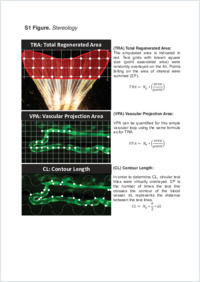Zebrafish caudal fin angiogenesis assay—advanced quantitative assessment including 3-way correlative microscopy
- Hlushchuk, Ruslan Institute of Anatomy, University of Bern, Bern, Switzerland
- Brönnimann, Daniel Institute of Anatomy, University of Bern, Bern, Switzerland
- Shokiche, Carlos Correa Institute of Anatomy, University of Bern, Bern, Switzerland
- Schaad, Laura Institute of Anatomy, University of Bern, Bern, Switzerland
- Triet, Ramona Institute of Anatomy, University of Bern, Bern, Switzerland
- Jaźwińska, Anna Department of Biology, University of Fribourg, Fribourg, Switzerland
- Tschanz, Stefan A. Institute of Anatomy, University of Bern, Bern, Switzerland
- Djonov, Valentin Institute of Anatomy, University of Bern, Bern, Switzerland
-
07.03.2016
Published in:
- PLOS ONE. - 2016, vol. 11, no. 3, p. e0149281
English
Background: Researchers evaluating angiomodulating compounds as a part of scientific projects or pre-clinical studies are often confronted with limitations of applied animal models. The rough and insufficient early-stage compound assessment without reliable quantification of the vascular response counts, at least partially, to the low transition rate to clinics. Objective: To establish an advanced, rapid and cost-effective angiogenesis assay for the precise and sensitive assessment of angiomodulating compounds using zebrafish caudal fin regeneration. It should provide information regarding the angiogenic mechanisms involved and should include qualitative and quantitative data of drug effects in a non-biased and time-efficient way. Approach & Results: Basic vascular parameters (total regenerated area, vascular projection area, contour length, vessel area density) were extracted from in vivo fluorescence microscopy images using a stereological approach. Skeletonization of the vasculature by our custom-made software Skelios provided additional parameters including “graph energy” and “distance to farthest node”. The latter gave important insights into the complexity, connectivity and maturation status of the regenerating vascular network. The employment of a reference point (vascular parameters prior amputation) is unique for the model and crucial for a proper assessment. Additionally, the assay provides exceptional possibilities for correlative microscopy by combining in vivo-imaging and morphological investigation of the area of interest. The 3-way correlative microscopy links the dynamic changes in vivo with their structural substrate at the subcellular level. Conclusions: The improved zebrafish fin regeneration model with advanced quantitative analysis and optional 3-way correlative morphology is a promising in vivo angiogenesis assay, well-suitable for basic research and preclinical investigations.
- Faculty
- Faculté des sciences et de médecine
- Department
- Département de Biologie
- Language
-
- English
- Classification
- Biological sciences
- License
-
License undefined
- Identifiers
-
- RERO DOC 259401
- DOI 10.1371/journal.pone.0149281
- Persistent URL
- https://folia.unifr.ch/unifr/documents/304878
Other files
Statistics
Document views: 106
File downloads:
- pdf: 74
- Supplementary material: 109

